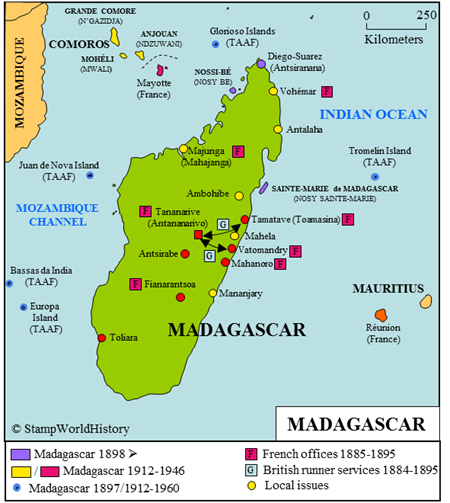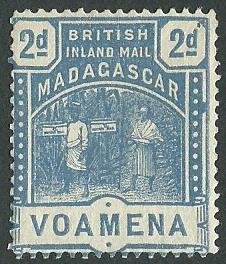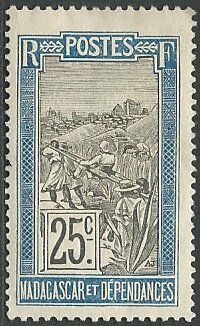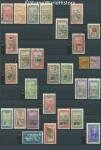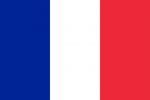
Madagascar
French possession
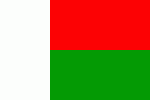
Madagascar
Republic
Quick reference
General issues: French protectorate 1895-1896, French colony 1896-1946, French overseas territory 1946-1958, French overseas territory/Self government/Malgache 1958-1960, Republic of Malagasy 1960-1975, Democratic republic of Malagasy 1975-1992, Republic of Madagascar 1992-Present
Country name on general issues: Madagascar, Malgache, Malagasy, Repoblikan ‘i Madagasikara
Special issues: French offices abroad 1889-1895, British offices abroad, Consular mail 1884-1886, British offices abroad, Inland mail 1895, Local issues Majunga 1895, Local issues Antalaha, Mahela, Manajary, Vohemar 1904, Local issues Ambohibe 1905
Currency: 1 Franc = 100 Centimes 1895-1960, 1 (CFA) Franc = 100 Centimes 1960-1974, 1 (Malgache) Franc = 100 Centimes 1974-1976, 1 Ariary = 5 (Malgache) Francs, 1 (Malgache) Franc = 100 Centimes 1976-Present
Population: 2 244 000 in 1900, 22 920 000 in 2013
Note: In this profile for several locations on and around Madagascar the names given by the French have been used since these would be the names collectors are most familiar with. For current names please refer to the map.
Political history Madagascar
The first contacts with Europe
Madagascar is a large island – the fourth largest in the world – off the coast of eastern Africa. In the first part of the 19th century Madagascar is divided into a number of kingdoms that, in the second part of the 19th century, are all to become part of the kingdom of Merina with Tananarive, in the center of the island, as its capital. Madagascar is known to Europeans from the 16th century. Located on the trade routes from Europe to India, Madagascar in the 17th and 18th centuries becomes home to large numbers of pirates.
In 1750, the French establish the colony of Sainte Marie de Madagascar, an island just off the east coast of Madagascar – one of the reasons being to counter piracy. Next, in 1841, the French establish themselves on Nossi-Bé – an island just off the west coast of Madagascar – and Mayotte – one of the Comoro Islands in the Mozambique Channel. The British, in the 19th century, also establish a presence on Madagascar. Having signed treaties with the king of Merina, in 1817 a British consulate is opened in Tananarive – Antananarivo as it called by the British and also is its current name.
The colonial era
The French, in 1883, decide to launch a military campaign on the mainland of Madagascar. The war that ensues, in 1885, leads to Madagascar becoming a de facto French protectorate. Diego-Suarez, on the northern tip of the island, is ceded to the French as a colony and is developed by the French to become a commercial and naval port. The British acknowledge the French claims to Madagascar in 1890. Further military campaigns result in Madagascar becoming a de jure French protectorate in 1895 and a French colony in 1896. The British withdraw from Madagascar in 1895.
In subsequent years, Madagascar is made the center of administration for the – mostly small or even very small – French possessions in the Indian Ocean that are – with the exception of Réunion – all annexed to Madagascar as follows:
- 1897: the islands of Bassas da India, Europe Island and Juan da Nova Island in the Mozambique Channel and Tromelin Island in the Indian Ocean
- 1898: the existing colonies of Diego-Suarez, Nossi-Bé and Sainte Marie de Madagascar
- 1912: the Comoro Islands – the colony of Mayotte and the islands of Anjouan, Grande Comore and Mohéli that had become separate French protectorates in 1886
- 1912: the Glorioso Islands – colonized by the French in 1897
- 1924: the French Southern & Antarctic Lands.
During WWII, the administration of Madagascar is loyal to the Vichy regime in France – the Vichy regime collaborating with Nazi Germany. The British occupy Madagascar in 1942 and subsequently transfer the administration to the Free French led by Charles De Gaulle. British forces will remain on the island until 1946.
The road to independence

Unique species of Madagascar: Golden crowned safika
In 1946, Madagascar becomes a French overseas territory. In 1958, Madagascar gains self government as Malgache and becomes independent as the republic of Malagasy in 1960. The changes in the French empire, from 1946, result in the detachment of several French possessions from Madagascar as separate French overseas territories as follows:
- 1946: the Comoro Islands as the separate French overseas territory of the Comoros
- 1955: the French Southern & Antarctic Lands are detached from Madagascar
- 1960: the Îsles Éparses – the Scattered Islands consisting of Bassas da India, Europa Island, the Glorioso Islands, Juan da Nova Island and Tromelin Island. Madagascar, until today, claims the Îsles Éparses.
Independence
Madagascar, in 1975, becomes a democratic republic with a one party political system. The Madagascar economy becomes a socialist style economy. This policy brings the Madagascar economy into a downward curve. In 1992, political and economic reforms are effected. Madagascar becomes a presidential republic with a multi party system. Supported by the International Monetary Fund, a program is launched for economic improvements. The name of the country is changed from Malagasy to Madagascar. Madagascar, until today, has a weak economy which depends on international support programs.
The Madagascar population consists, for the larger part, of the Malagasy. It is supposed that people first settled on Madagascar between 305 A.D and 550 A.D., coming from the Indonesian archipelago. These would have mixed with Bantu peoples from eastern Africa that had settled on Madagascar from 1000 A.D.
Madagascar has exceptional flora and fauna. When the continents were formed, Madagascar was split off at an early stage, subsequently following its own evolutionary path. Of the species found on Madagascar, 90% is found only on Madagascar.
Postal history Madagascar
The first French post offices
The first post offices to be opened, in what is now Madagascar, are the offices on the French possessions of Nossi-Bé and Sainte Marie de Madagascar in the mid 19th century. The first stamps to be used are the general issues for the French colonies from around 1860. The next post office is opened in Diego-Suarez when it becomes a French possession in 1885.
On the mainland of Madagascar, the French open post offices from 1885. Here also the general issues for the French colonies are used initially. Specifically for these offices, the French issue stamps from 1889. The first issues are overprints on the general issues of the French colonies with a new face value. In 1891, a set is issued from local design and print. Further overprints – now on stamps of France – follow in 1895, the overprint reading ‘Poste Française Madagascar’. Provisional stamps are issued also in 1895 by the postmaster of Majunga – French stamps overprinted with a new face value. Only few copies of these exist.
The British runner services
The British have also issued stamps for use on Madagascar – issues for two runner services. The first connected Tananarive with the French office in Tamatave. This runner service was, at first, a private initiative, later to be taken over by the British consulate. Stamps are issued from 1884 to 1886 – stamps of local design and print inscribed ‘British Consular Mail Antananarivo’. The second runner service – again a private initiative – connected Tananarive with Vatomandry – from there mail would be shipped to Natal and then to its final destination. Stamps were issued in 1895 – a first set of local design and print and a second more sophisticated set, both inscribed ‘British Inland Mail Madagascar’. These services were shut down when the British withdrew from Madagascar in 1895.
General issues
From 1895, Madagascar has issued stamps as a French protectorate and colony, as Malgache and Malgasy and, currently, as the republic of Madagascar. Several French possessions that were annexed to Madagascar had, prior to annexation, issued stamps of their own: the colonies of Diego-Suarez, Nossi-Bé and Sainte Marie de Madagascar and the Comoro Islands of Anjouan, Grande Comore, Mayotte and Mohéli. These would be superseded by the issues of Madagascar after annexation. The remaining stock of Diego-Suarez and the Comoro Islands was reissued in 1902 and 1912 respectively – overprinted with a new face value and valid for use in all of Madagascar.
Local issues
In 1904, local issues appeared during shortages of stamps in several towns on Madagascar. These were bisects of issues from Diego-Suarez and Madagascar that would be affixed to covers and overprinted with an overprint reading ‘Affranchissement exceptionel – faute de Timbres'[1]‘Exceptional franking – shortage of stamps’ or similar overprints.[2]The worldwide catalogs differ on their listing of these issues, the most extensive listing is that of Yvert & Tellier with general and local issues for Antalaha, Mahela, Manajary and Vohemar. Michel lists the general issues and the issues for Antalaha and Vohemar. Scott considers the issues ‘unnecessary and speculative’. Yvert & Tellier lists another 1905 local issue for Ambohibe – a bisected issue from Diego-Suarez now with a handwritten overprint.
For an overview of the political and postal developments in the form of a diagram, please refer to the country diagram of French Africa – Indian Ocean.
Album pages
← Previous page: Lourenço MarquesNext page: Malawi →

